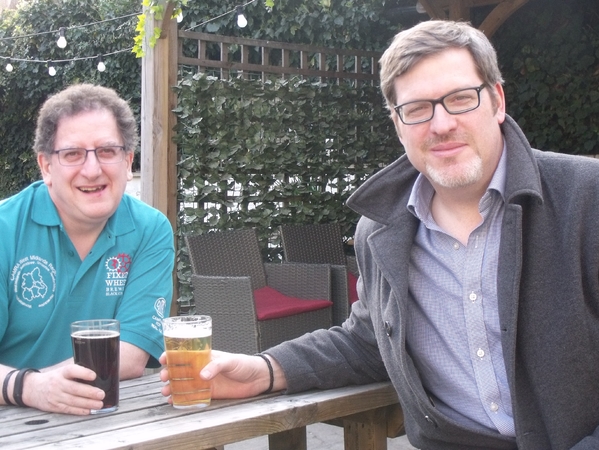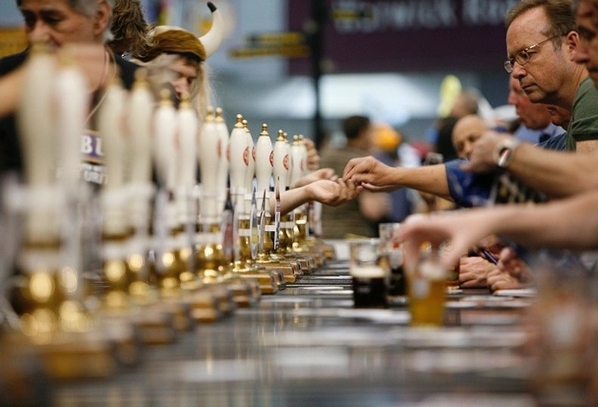New look CAMRA out to broaden base
Added: Sunday, March 31st 2019

There’s change at the top of the Campaign for Real Ale. A new chairman and chief executive are determined to improve CAMRA’s image, reach out to younger drinkers and convince all pubgoers that the 193,000-strong organisation is about more than just handpumps on bars and casks in the cellar.
Nik Antona (pictured left) will take over as CAMRA national chairman following the annual meeting in April. Tom Stainer is the new chief executive at the head office in St Albans. They’re not old crusties, Private Eye and Viz stereotypes, though they have earned their spurs in the campaign.
Nik has served on the National Executive for several years and was in charge of beer festivals before becoming finance director. Tom is a professional journalist and worked as a reporter for the pub trade paper the Morning Advertiser before editing CAMRA’s newspaper What’s Brewing and its magazine BEER.
Both were centrally involved in the Campaign’s Revitalisation project that ran from 2016 to 2018. This reached out to the membership through public meetings and online voting to see if there was support for broadening the campaign’s base, embracing other types of beer and putting more emphasis into supporting pubs. Most of the proposals were backed but, while 72 per cent voted to endorse other beer styles, under company law the proposal failed to reach the necessary 75 per cent to enable the change to take place.
But Nik and Tom are quick to point out that a proposal to allow CAMRA beer festivals to include key kegs was supported by the necessary majority and many festivals are now supporting this change.
“A number of festivals have key kegs with explanations that are not dogmatic about the different ways beer can be served. I accept that we’ve poor about explaining this in the past,” Tom says. “We need to represent all pubgoers.”
“We may revisit Revitalisation in a few years,” Nik adds, “but in reality we’re doing it now. Younger people are drinking cask but they want to try different things – they want to drink good beer but not necessarily from casks.”

On the thorny question of craft beer, I said when I visited the Beavertown Brewery I found the beers were stored in key kegs, they were not filtered or pasteurised, contained yeast and were served by low gas pressure – two pounds per square inch, identical to the natural CO2 in a cask. What, I asked, would they call this type of beer?
“Real ale!” Nik and Tom said in unison. Nik stressed that the campaign has approved key kegs and eco kegs and similar containers.
“We’re not obsessed with containers. The annual conference last year approved cask breathers. If there’s no gas in contact with the beer, then it’s real ale,” Nik adds.
They agree that cask beer had a bad time in 2018, with sales in sharp decline, but they say there are signs of a revival. Both BrewDog and Cloudwater are returning to cask production and Shepherd Neame has launched a cask club promotion for its beers.
“The stats are not always helpful,” Tom says. “They say craft beer is booming – but what is craft? Real ale is craft beer!
“But we’re not complacent. We have to improve the marketing and the quality of cask. We have to avoid old-fashioned and sexist images – some breweries are very old fashioned.
“And quality is key. If your first pint of cask beer is not good you won’t got back for a second. Brewers and pubs must get it right.”
Nik adds that beer festivals are looking at serving temperatures to see if cask beer can be served colder.
“If it’s too cold it can warm up, but if it starts warm it can't get colder,” Tom says.
On the need to attract younger members, Tom says: “Branch meetings mustn’t be dull and the old guard mustn’t be blockers. New, young members must be involved and welcomed. They could be branch press officers or run beer festivals.”
And festivals also need to invite a broader audience, they admit. Nik, in charge of festivals until 2018, says while attendance at the Great British Beer Festival (picured above) was down last year, CAMRA had no plans to leave Olympia and move elsewhere.
“GBBF is a London institution,” he says. “We have a fantastic deal with Olympia – it would cost far more to stage the festival elsewhere. And the festival is too big to move around the country – we get 48,000 at Olympia.
“We also have the winter festival, which does go to different venues. And we may add a third national festival. We need to have other events at GBBF to attract more people – food and different types of drink. For example, there’ll be a gin bar this year.”
Tom thinks comparisons with Craft Beer Rising are misplaced. “CBR is a small niche – we’re appealing to a wider audience. But we could have a key keg sector at GBBF.”
“Craft festivals have a restricted beer choice,” Nik adds. “There are mainly IPAs but you won’t find mild, traditional bitter, old ale or barley wine.”
I met Nik and Tom one day after Magic Rock announced it had been bought by Lion of Australia, part of the Kirin group in Japan. The takeover came hard on the heels of Fuller’s sale of its brewery and brands to Asahi. Can CAMRA do anything to stop this erosion of independent breweries in Britain?
“If the owners or shareholders want to sell, there’s nothing we or anyone else can do to stop them,” Tom says resignedly. “We have to encourage the owners of breweries to offer a good choice of beer and to see pubs as viable businesses.”
To that end, and implementing a decision that came from the Revitalisation project, CAMRA will step up its support for community pubs in urban as well as rural areas. Nik Antona says the campaign has been encouraging local branches, along with other interested groups, to get Asset of Community Value status placed on endangered pubs and to retain them as vital hubs offering great beer.





